7 Best Microphone Under 500-1000-2000-3000-5000-10000 In India 2023
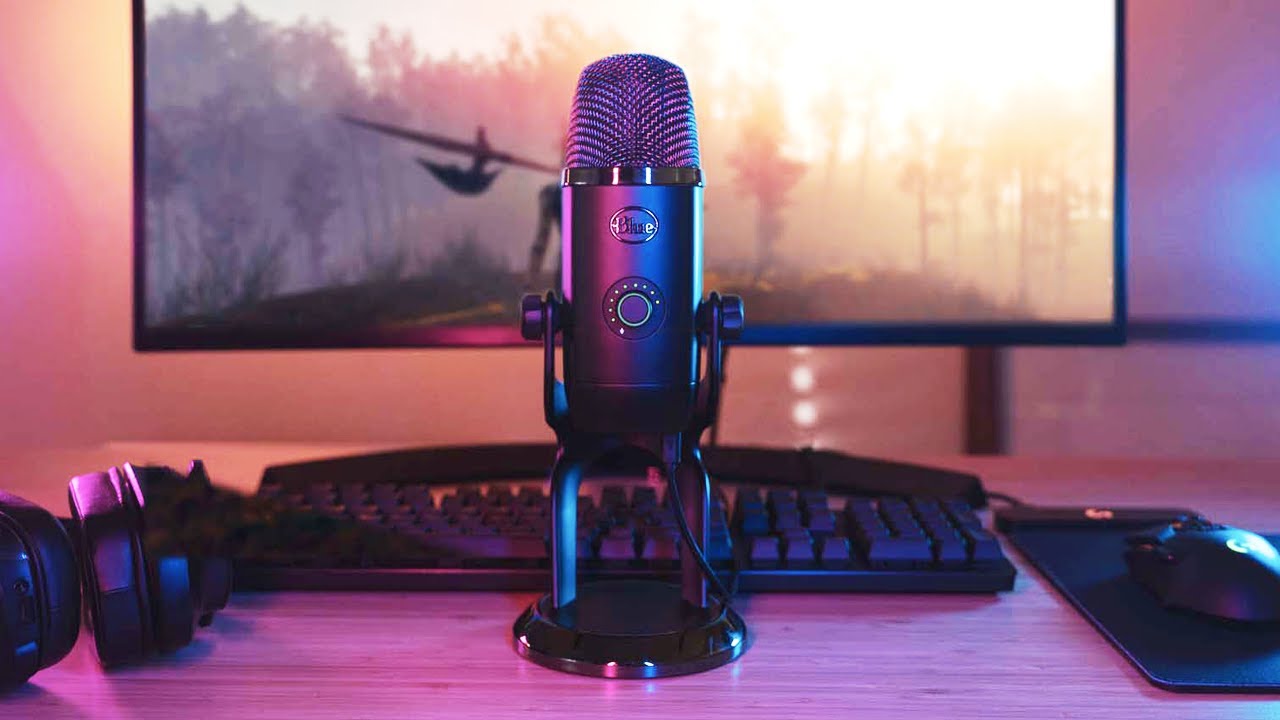
The microphone is a critical tool in the music industry, broadcasting, podcasting, and basically any application that involves capturing sound. It transforms acoustic sound waves into electric signals which can then be amplified, recorded, or transmitted.
There are various types of microphones- condenser, dynamic, ribbon, cardioid, omnidirectional, bidirectional, shotgun, lavalier, boundary, headset, handheld, each designed for a specific requirement. Some are best for recording vocals and instruments while others excel in live performance, podcasting, voiceovers, ASMR, gaming or karaoke setup environments.
Choosing a microphone largely depends on its intended use, the performance quality you desire, and your budget. Below are some factors to consider when making your choice.
7 Best Microphones Under 500-1000-1000-1500-2000-5000-10000 In India
1. MAONO AU-400 Microphone: Under 500
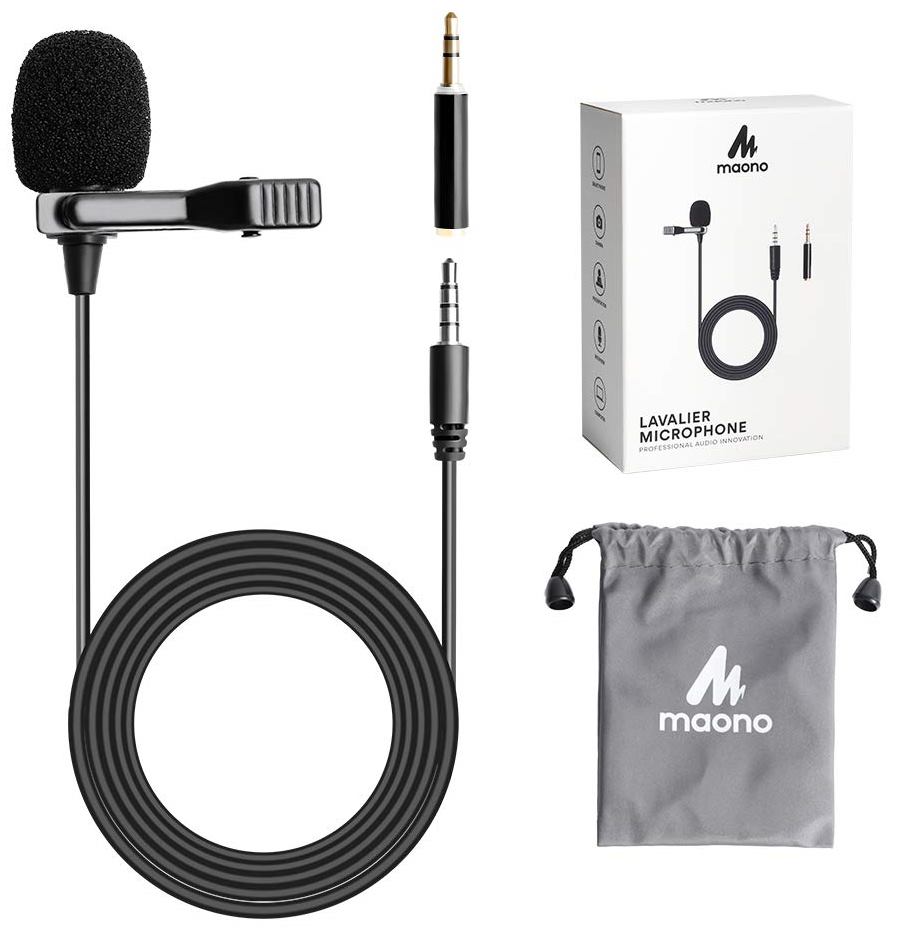
- 1 Microphone
- Adapter
- Metal Clip
- Wind Muff
The first one on our list is the MAONO AU-400 microphone. It is a highly affordable device that we came across and might fit your budget. This is a collar mic you might have typically encountered in different video conferences, podcasts, and even YouTube videos.
Apart from this, multiple features around this mic might interest you and make it worth spending money on. Here are a few of them.
Features
Compatibility- The best part of this mic is its wide range of compatibility. You can also plug in the auxiliary cable to your smartphones, computers, laptops, DSLRs, tablets, and multiple devices. You can get a connector for iPhones, and you are good to go.
Usability- Since the microphone is a collar mic, it is easy to use and set up. It can be carried around clipped to the shirt or any clothing without affecting the sound quality.
Sound Quality- It uses high-quality voice technology that picks up the sound around the mic. You can use it to record music, take online classes, video chats, and conferences.
- Easy to clip on the on tie or collar
- Exceptional sound quality
- Wide compatibility
- Easy to be carried around
- Highly affordable and cheap
- It needs an extra connector to connect with an iPhone
- Noise cancellation isn’t the best
2. Boya ByM1 Microphone: Under 1000
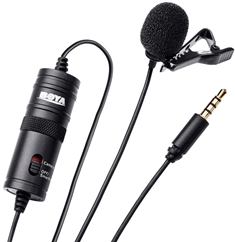
- Smartphones, DSLRs, computers
- 3.5mm 4-pole gold plug
- 20ft Audio Cable
Next up, we have another collar mic used by thousands of customers worldwide. It has a reasonable price range and also fits perfectly in your budget. The Boya ByM1 comes with a 20ft audio cable to make it easy for you to create your setup conveniently.
Now, that is not all about this Lavalier microphone. Apart from its decent audio quality, multiple other features might intrigue you to buy one for yourself. Here is all you need to know.
Features
Compatibility- This mic is compatible with all the devices you can think of at the top of your head. Smartphones, DSLRs, computers, etc., you can connect with them all.
Usability- It comes with a 3.5mm jack that is universal and comes in handy no matter what device you plug in. Moreover, it does not need any sound card, a simple plug-and-go mic that is easiest to set up.
Sound Quality- The sound quality isn’t the best. But using the right software and making a few changes to the settings with this mic will work just up to the mark.
- Comes with 20ft long cable
- Easy to set up and manage
- Perfect for smartphones and cameras
- It does not need any sound card to work
- Good build quality
- Average sound quality
- The issue with battery placement
3. Powerpak BM-700 : Under 1500
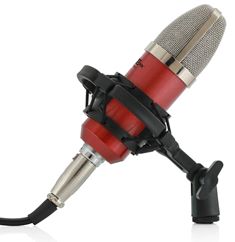
- 48v phantom power adapter
- Cardioid pick-up pattern
- metal microphone shock mount
- Ball-type anti-wind foam
As we move up the cost ladder, you will come across high-end microphones that do not compromise on quality. The Powerpak BM-700 might be the right option for recording audio, YouTube videos, and other professional purposes. Such mics are known to be condenser microphones since they are used to capture audio with more accuracy.
This isn’t like any other mic that works with every device. It needs a lot of power to give you the best output. Here is what you can know.
Features
Compatibility- Unlike others, this mic works best with a personal computer. You will not need any adapter to make it work. However, to use it with a laptop, ensure you have 48v phantom power or an adapter for enough power to make this work. Furthermore, you cannot connect with a smartphone or camera.
Usability- It might sound difficult, but it is very easy to set up with the right device. Moreover, it comes with a metal shock mount, foam cap, and mic cable for a perfect setup.
Sound Quality- While using it to record podcasts, conferences, etc., the mic’s design minimizes background noise, and the exceptional shock mount reduces other outside noise while handling.
- Build quality is exceptional
- The sound quality is amazing
- Highly-affordable condenser mic
- Works well for professional use
- Minimizes background noise
- Shock mount quality could have been better
- Only for personal computer
4. MAONO AU-PM360TR TRS Mic : Under 2000
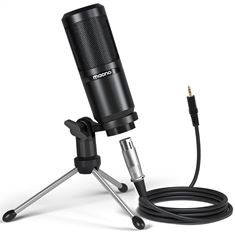
- No additional driver software
- Mac or Windows connect
- Stable tripod stand
- 180-degree flexible design
This might be it if you are looking for a professional-grade condenser mic on a good budget. MAONO is one of the most popular microphone brands worldwide, and the AU-PM360TR TRS Condenser Mic is another masterpiece.
It has everything you need: excellent sound quality, good noise cancellation, and more. Let us look at the details here.
Features
Compatibility- This MAONO mic is compatible with smartphones, computers, laptops, etc. Moreover, you can connect with Windows and Mac operating systems, whichever one you own.
Usability- The best part of this microphone is that it weighs only 450g and is easy to set up. It is perfect for YouTube recording, Podcast, Gaming, studio, and much more. You will not require any additional software or sound card for installation; it is a simple plug-and-go.
Sound Quality- Considering the construction of the mic, it reduces or cancels the background noise and only focuses on the direct sound. You can attach it to the tripod stand that is 180 degrees flexible, making it perfect for voice-over.
- It comes with a tripod stand
- Exceptional sound quality
- Easy to set up and adjust
- Perfect for recording podcasts and YouTube videos
- Needs more height stand
5. Maono AU-A03 Condenser Microphone: Under 3000
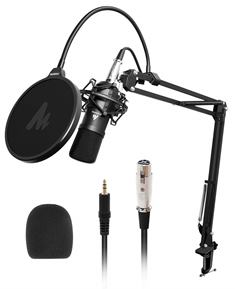
- Cardioid Pick-up Pattern
- Compatible to Windows and Mac
- Sturdy boom arm set
- Plug and recording
Another one from Maono that beats all the other microphones in this price range. It comes with a complete kit that you will need to set up your studio. Simply follow the instructions, and you can set up everything within minutes.
This kit contains a mic, metal shock mount, foam mic windscreen, mic arm, table mounting clamp, a cable, and an adapter. All these are of the best quality and brand that do not need replacement. Here is everything you need to know.
Features
Compatibility- You can use this mic with your laptops and computers. Since these are high-end microphones, you cannot use them with your smartphones or even DSLRs. For computers, it will also need a Y adapter already provided in the kit.
Usability- Connect the mic to the computer using the 3.5 mm cable provided in the kit. Attach the pop filter and foam windscreen to get the best sound output to filter out any background noise or whispers.
Sound Quality- You get the best sound quality with proper equipment and software. This high-end device is perfect for studio, podcasting, and music recording.
- Perfect for both beginners and professionals
- Exceptional quality on an affordable budget
- Cardioid pattern reduces background noise
- Supports both Windows and Mac OS
- Not for smartphones
6. MAONO AU-902 Condenser Microphone: Under 5000
- 2 adjustment buttons
- Cardioid pick-up pattern
- Non-slip and Rotatable Design
- Compatible with Windows and Mac
When we speak of the best microphones, MAONO AU-902 stands out. Yes, we have mentioned multiple mics by this brand, but being the best among hundreds of brands, there is no better option.
From its design to its usage, everything checks the box. Your ideal microphone easily connects with your system and has the simplest setup you could ask for. Here is what we have learned so far.
Features
Compatibility- Connect it to your computers, laptops, and even smartphones. It works with both Windows and Mac OS. Since it comes with a USB A to Type C cable, it easily works with any microphone. However, for iPhones, you might have to purchase a different connector.
Usability- Since this is a high-end mic, you will see many professionals on YouTube streams, podcasts, and even voice-overs; people often use this. The best is to connect the headphone jack to the mic to keep in check what you are recording.
Sound Quality- It comes with properly designed audio circuitry that focuses entirely on the input and reduces or filters out any background voice. You will hardly hear any complaints about the sound or other humming noise while recording.
- Two buttons are provided for both the mic and headphones
- Zero latency monitoring
- Wide compatibility with your devices
- Exceptional build quality
- Expensive
- Not the best for beginners
7. Blue Yeti USB Microphone: Under 10000
- Onboard audio controls
- Adjust the height and pivot
- Multiple pickup patterns
- Easy to set up and function
It is one of the best microphones in India but also among the most expensive in this list. For many users with a good budget and are ready to invest for the long term in a device, Blue Yeti is the best among all. You will love the build quality and the overall design of the mic that gives it a modern look.
Unlike the obvious ones, it has many other features you cannot ignore. The more you read about it, the better you will understand its quality and software. Here is what you should see.
Features
Compatibility- Speaking of compatibility, you can easily connect your computer and your laptop. It is not in my best interest to use it with a smartphone. You will never get the best sound quality that this mic can produce.
Usability- You can adjust the height and pivot the mic on the table to give that stability while recording. The best is that it has multiple pickup patterns you can record in Cardioid, Omni, bidirectional, and stereo pickup patterns.
Sound Quality- It has the best sound quality with no compromise whatsoever. The software can check the enhanced effects, advanced modulation, and HD audio samples. To add more, you can also control its headphone’s volume, mute button, and so much more. Also, this mic has no latency monitoring, recording the best sound in real time.
- Adjustable stand to pivot on the table
- Works perfectly with both Windows and Mac
- Easy to set up and function
- It does not have any latency monitoring
- Highly expensive
- It needs to be mounted
Buying guide: Tips on how to choose the best microphone for your needs
- Consider the specific requirements of your intended use. Whether for recording music, podcasting, streaming, or other applications, understanding your purpose will help narrow down microphone options.
- Research the different microphone types and their characteristics. Dynamic microphones are known for their durability and ability to handle high sound pressure levels, while condenser microphones offer greater sensitivity and accuracy. Ribbon microphones provide a warm and vintage sound.
- Choose a pickup pattern suitable for your needs. Cardioid is versatile for most applications, while omnidirectional is ideal for capturing ambient sound. Bidirectional patterns are suitable for interviews or duet recordings.
- Assess the microphone’s frequency response. A wider frequency response ensures the microphone can accurately capture a broad range of sounds. Consider the specific frequencies you need to capture for your intended use.
- Pay attention to microphone sensitivity, which determines how well the microphone can pick up quiet sounds or handle loud sources without distortion.
- Consider the microphone’s impedance and compatibility with your recording equipment. Ensure the microphone’s impedance matches or can be adjusted to match your recording device.
- Read reviews and consider the reputation of the microphone brand. Look for reliable and reputable manufacturers known for producing high-quality microphones.
- Test the microphone if possible. If you can try out the microphone before purchasing, take advantage of it. This will give you firsthand experience of its sound quality and suitability for your needs.
- Consider additional features and accessories. Some microphones may offer integrated signal processing, wireless connectivity, or audio interfaces and accessories compatibility. Determine if these features are necessary for your specific use case.
- Compare prices and consider your budget. While investing in a quality microphone is important, it’s also essential to stay within your budget. Determine the maximum amount you’re willing to spend and find a microphone with the best features and value for that price range.
Choosing the best microphone for your needs requires considering various factors, including your budget, intended use, environment, and desired sound. Understanding the different types of microphones, such as dynamic, condenser, and ribbon, allows you to choose a microphone with the appropriate characteristics for your specific requirements. Additionally, considering the pickup pattern, frequency response, sensitivity, and impedance helps ensure optimal performance.
- Dynamic Microphone: Dynamic microphones are rugged and versatile, making them suitable for live performances and studio recordings. They use a diaphragm that vibrates in response to sound waves, then moves a coil of wire in a magnetic field, generating an electrical signal. Dynamic microphones are known for their durability and ability to handle high sound pressure levels, making them ideal for capturing loud sound sources such as drums and guitar amplifiers.
- Condenser Microphone: Condenser microphones are more sensitive and accurate, making them popular for studio recordings and capturing vocals. They have a thin diaphragm that acts as one plate of a capacitor, with the varying electrical charge generated by sound waves vibrating the diaphragm. Condenser microphones require power, usually through phantom power or batteries, to charge the capacitor and process the electrical signals. They offer a broader frequency response and better transient response than dynamic microphones, making them suitable for capturing a wide range of sounds with greater detail.
- Ribbon Microphone: Ribbon microphones are known for their warm and smooth sound reproduction, making them desirable for recording vocals, strings, and brass instruments. They work by using a thin strip of metal ribbon suspended in a magnetic field. As sound waves hit the ribbon, it vibrates, inducing an electrical signal that is then amplified. Ribbon microphones are delicate and require careful handling, as they can be easily damaged by excessive wind or high sound pressure levels. However, they are highly regarded for their natural and vintage character.
List the available pickup patterns, such as cardioid, omnidirectional, and bidirectional.
Microphones have different pickup patterns that determine how they capture sound from different directions. The shape of the polar pattern indicates the pickup pattern, which represents the microphone’s sensitivity to sound from different angles.
- Cardioid Pickup Pattern: This pickup pattern is heart-shaped and is most commonly used in microphones. Cardioid microphones are more sensitive to sounds from the front while reducing sensitivity to sounds from the sides and rear. They are ideal for capturing a focused sound source while minimizing background noise and feedback. This makes them suitable for vocals, solo instruments, and studio recordings.
- Omnidirectional Pickup Pattern: Omnidirectional microphones capture sound equally from all directions. They are ideal for capturing ambient sound or recording group performances. Omnidirectional microphones are less prone to proximity effect, a bass boost that occurs when the sound source is close to the microphone. They can be used in conference settings, field recordings, and capturing room ambiance.
- Bidirectional Pickup Pattern: Also known as the figure-eight pattern, bidirectional microphones are most sensitive to sounds from the front and rear while minimizing sensitivity to sounds from the sides. They are commonly used for interviews, capturing sound from both the interviewer and interviewee. Bidirectional microphones can also effectively capture duets or two instruments facing each other.
- Hypercardioid and Supercardioid Pickup Patterns: These pickup patterns are similar to the cardioid pattern but offer a narrower focus. Hypercardioid and supercardioid microphones have a greater rejection of sounds coming from the sides and rear, making them suitable for situations where unwanted noise needs to be minimized, such as in live performances or stage productions.
What to consider when choosing a microphone:
When selecting a microphone that best suits your needs, there are several factors to consider:
- Budget: Determine how much you are willing to spend on a microphone. It is possible to find quality options within various budget ranges: 500 INR, 1000 INR, 1500 INR, 2000 INR, 3000 INR, 5000 INR, and 10000 INR.
- Intended use: Identify the primary purpose for which you will be using the microphone. Are you planning to use it for recording music, podcasting, gaming, broadcasting, or other specific applications?
- Environment: Consider where you will be using the microphone. Will it be in a studio, live setting, home, or portable setup? Different environments may require different microphone types to achieve the desired results.
- Type of sound: Determine the type of sound you want to capture. Are you focusing on vocals, instruments, ambiance, or a combination? Different microphones excel in specific areas.
Microphone Buying Guide
Microphone Type
Different types of microphones serve different functions. They range from condenser microphones, known for their detailed and accurate sound capturing abilities, to dynamic microphones, lauded for their durability and ability to handle high sound pressure levels. There are also specific mics tailored for every potential use case. A proper selection ensures you pick a microphone suited for your needs.
Polar Pattern
The polar pattern of a microphone refers to the sensitivity of the microphone to sounds arriving at different angles. These include cardioid, omnidirectional, bidirectional, and shotgun patterns. Depending on your use, one option might be more suitable than the other.
Frequency Response
The frequency response refers to the range of frequencies that a microphone can capably pick up and reproduce. Some microphones have improved low or high-frequency response, catering to specific sound requirements.
Sensitivity and Impedance
The sensitivity of a microphone determines how quiet a sound the microphone can detect, while impedance refers to the microphone’s resistance to an electrical current (signal). Both factors significantly affect the quality and clarity of your sound output.
Connectivity
Microphones can be connected to an audio interface or recording device using an XLR connector, 1/4″ TRS jack, 3.5mm TRRS jack, USB, Bluetooth, or Wi-Fi depending on the model. Select a mic that’s compatible with your existing equipment.
Accessories
Accompanying accessories also come into play when choosing a microphone. A pop filter or windscreen may help reduce plosive sounds, while a shock mount minimizes vibration noises. A boom stand provides flexibility when positioning your microphone.
Conclusion
Here is all you need to know about the best microphones in India, from the ones that will fit your budget to the high-end ones that are perfect for professionals. Simply make sure to go through the list before you can choose the right one for yourself.
Each of these mics has been tested and then reviewed so that you can get the best options among the hundreds available in the market. The best ones for us must be Blue Yeti, Maono AU-A03, and MAONO AU-400.